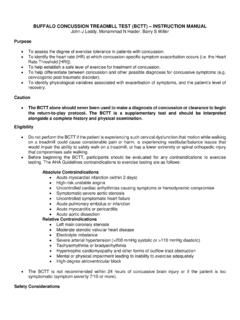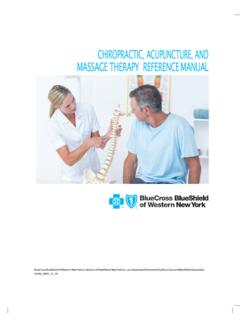Transcription of Protocol for Cervical Fusion Surgeries
1 J. Patrick Caulfield, Edward J. Bieber, Ira D. Fisch, Kurt C. Schluntz, Andre R. Gazdag, Christopher J. Cannova, Mahidhar M. Durbhakula, Sridhar M. Durbhakula, Craig A. Miller, Joseph R. O Brien, Eric J. Feuchtbaum, Andrew S. Holmes, Timothy Bhattacharyya, Robert R. Buber, Protocol for Cervical Fusion Surgeries This should be divided into 3 phases primarily based on the post-surgical time frames. However, if patient cannot demonstrate tolerance to, or correct completion of program progression, phases may be prolonged as necessary. Please note that this Protocol should not serve as a substitute for clinical judgement.
2 Therapists should take into consideration additional factors, such as patient age, prior functional status, as well as concurrent health conditions when implementing this rehabilitation program. Initiation of outpatient physical therapy will be determined by surgeon on a case by case basis. PHASE 1 Rehabilitation Goals for 1-6 weeks: 1. Be sure patient knows home exercise (mostly isometrics) and beginning muscle recruitment for stabilization and postural support. 2. Increase daily activity levels; work on restoration of any mobility losses, mostly with walking and calf pumping. 3. Remind patient to continue to observe precautions as instructed below. 4. Reinforce use of neck brace or Cervical collar if patient has been instructed to use one.
3 Re-evaluate effectiveness of brace. 5. Initiate home walking program, trying to increase distance to one to two miles by six week checkup with the surgeon. 6. Determine mechanical means of pain control for the patient using physical agents, positioning, support, or peripheral movements, as needed. 7. Release soft tissue restrictions/muscle spasms. Soft tissue mobilizations appropriate during this initial phase starting in the 4th week from surgery, and once incisional areas are fully healed. 8. Reinforce proper posture and body mechanics for all activities of daily living (ADLs). Prepare to wean from brace or Cervical collar after 6 weeks, if neck brace has been used. Ensure that patient can correctly complete log roll with positional changes.
4 9. Emphasis on proper breathing mechanics. Precautions: No lifting greater than 5 pounds until cleared by surgeon (usually by 4-6 weeks after procedure). No active side bending, twisting, or stretching of Cervical spine . Gentle active motions in pain free range may begin in week 4. No resisted overhead exercise. J. Patrick Caulfield, Edward J. Bieber, Ira D. Fisch, Kurt C. Schluntz, Andre R. Gazdag, Christopher J. Cannova, Mahidhar M. Durbhakula, Sridhar M. Durbhakula, Craig A. Miller, Joseph R. O Brien, Eric J. Feuchtbaum, Andrew S. Holmes, Timothy Bhattacharyya, Robert R. Buber, No sudden, jerky spinal motions.
5 No high impact activity. Rehabilitation Program, 1-6 weeks Exercises appropriate for this phase include: a. Scapular retractions b. Beginning in week 4 at the earliest, isometric exercises for Cervical spine into side bending, rotation, flexion, and extension. Position of training these muscles is dependent on patient tolerance, and therapist discretion. c. Gentle seated thoracic extensions over chair while supporting neck in collar. Monitor for excessive Cervical spine motion. d. Gentle pec stretching in supine with towel roll behind mid scapular area if this is tolerable. e. Beginning in week 4 at the earliest, Cervical AROM in all directions. Gentle, and pain free. f. Sitting-standing, and standing-sitting with emphasis on erect spinal posture.
6 G. Upper extremity neural glides to prevent dural scarring; exercise caution to avoid inflaming neural tissue. Arm motions only prior to the 4th week following surgery. Gentle Cervical side bending can be integrated after week 4. h. Deep neck flexor training. This can be commenced while using collar by pressing into collar. Once collar is removed, patient can achieve this by pressing into fist. Begin in supine with adequate support, progress to neutral position. As patient progresses, work to increase hold times, and frequency of exercise completion. i. Walking (no bike). j. Postural education, emphasis on upright sitting posture, use of Lumbar support roll. k. Lumbar spine stability if appropriate.
7 Promote neutral spine with all therapeutic exercises. **If patient cannot complete these correctly, they should not be performed independently. Review of all precautions. Reinforce lifting limit. Continue to emphasize basic stabilization exercises, and maintaining neutral spine . Use fully supported positions until patient shows good control and has minimal symptoms during exercise. Encourage walking. Reinforce use of neck brace if required. If brace is optional, reassess patient s capability to do functional activities without pain, with and without the brace. Start to wean the patient from the brace or Cervical collar as pain-free function improves. J. Patrick Caulfield, Edward J.
8 Bieber, Ira D. Fisch, Kurt C. Schluntz, Andre R. Gazdag, Christopher J. Cannova, Mahidhar M. Durbhakula, Sridhar M. Durbhakula, Craig A. Miller, Joseph R. O Brien, Eric J. Feuchtbaum, Andrew S. Holmes, Timothy Bhattacharyya, Robert R. Buber, Have patient record walking times or distances each day, starting with 10 minutes or less, 1-2 times per day, progressing tolerance to 30 minutes. Set distance, time, or step goals for 6 weeks post-surgery. Review pain control strategies each visit. Incorporate with self-help care. Work on specific stretching and soft tissue/joint mobilization to maximize function in adjacent areas, such as thoracic spine .
9 Gentle thoracic spine mobilizations may be performed (if no contraindications for mobilizations) while maintaining neutral Cervical spine position. PHASE 2 Rehabilitation goals for 6-12 weeks: 1. Continue spine stabilization exercises. 2. Progress aerobic program in intensity and/or duration in improve aerobic level and achieve at least three miles/day walking distance by twelve weeks if appropriate, based on prior level of function. 3. Continue release of soft tissue restrictions/muscle spasms using manual therapy if appropriate. 4. Include motor control considerations in the treatment program. Integrate coordination and quality of movement in the exercise. Test and train balance as part of the program.
10 5. Instruct in proper body mechanics and postures for patient s ADLs. 6. Continue with neural mobilization and attention to upper extremity flexibility. 7. Once 5 pound lifting restriction has been lifted during follow up visit with surgeon, gradual increments in resistance are appropriate during exercise program, and daily activity. 8. Continue work on specific stretching and soft tissue/joint mobilization to maximize function in adjacent areas from Fusion site, such as thoracic spine . Gentle thoracic spine mobilizations may be performed (if no contraindications for mobilizations) while maintaining neutral lumbar spine position. Precautions: Patients should seek clearance from surgeon for lifting greater than 10 pounds if daily function of patient requires them to do so.









